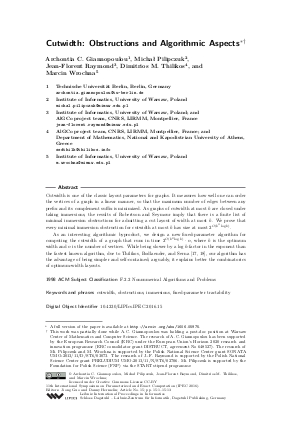Cutwidth: Obstructions and Algorithmic Aspects
Authors Archontia C. Giannopoulou, Michal Pilipczuk, Jean-Florent Raymond, Dimitrios M. Thilikos, Marcin Wrochna
-
Part of:
Volume:
11th International Symposium on Parameterized and Exact Computation (IPEC 2016)
Part of: Series: Leibniz International Proceedings in Informatics (LIPIcs)
Part of: Conference: International Symposium on Parameterized and Exact Computation (IPEC) - License:
 Creative Commons Attribution 3.0 Unported license
Creative Commons Attribution 3.0 Unported license
- Publication Date: 2017-02-09
File

PDF
LIPIcs.IPEC.2016.15.pdf
- Filesize: 0.56 MB
- 13 pages
Document Identifiers
Subject Classification
Keywords
- cutwidth
- obstructions
- immersions
- fixed-parameter tractability
Metrics
- Access Statistics
-
Total Accesses (updated on a weekly basis)
0Document
0Metadata
Abstract
Cutwidth is one of the classic layout parameters for graphs. It measures how well one can order the vertices of a graph in a linear manner, so that the maximum number of edges between any prefix and its complement suffix is minimized. As graphs of cutwidth at most k are closed under taking immersions, the results of Robertson and Seymour imply that there is a finite list of minimal immersion obstructions for admitting a cut layout of width at most k. We prove that every minimal immersion obstruction for cutwidth at most k has size at most 2^O(k^3*log(k)). As an interesting algorithmic byproduct, we design a new fixed-parameter algorithm for computing the cutwidth of a graph that runs in time 2^O(k^2*log(k))*n, where k is the optimum width and n is the number of vertices. While being slower by a log k-factor in the exponent than the fastest known algorithm, due to Thilikos, Bodlaender, and Serna [J. Algorithms 2005], our algorithm has the advantage of being simpler and self-contained; arguably, it explains better the combinatorics of optimum-width layouts.
Cite As Get BibTex
Archontia C. Giannopoulou, Michal Pilipczuk, Jean-Florent Raymond, Dimitrios M. Thilikos, and Marcin Wrochna. Cutwidth: Obstructions and Algorithmic Aspects. In 11th International Symposium on Parameterized and Exact Computation (IPEC 2016). Leibniz International Proceedings in Informatics (LIPIcs), Volume 63, pp. 15:1-15:13, Schloss Dagstuhl – Leibniz-Zentrum für Informatik (2017)
https://doi.org/10.4230/LIPIcs.IPEC.2016.15
BibTex
@InProceedings{giannopoulou_et_al:LIPIcs.IPEC.2016.15,
author = {Giannopoulou, Archontia C. and Pilipczuk, Michal and Raymond, Jean-Florent and Thilikos, Dimitrios M. and Wrochna, Marcin},
title = {{Cutwidth: Obstructions and Algorithmic Aspects}},
booktitle = {11th International Symposium on Parameterized and Exact Computation (IPEC 2016)},
pages = {15:1--15:13},
series = {Leibniz International Proceedings in Informatics (LIPIcs)},
ISBN = {978-3-95977-023-1},
ISSN = {1868-8969},
year = {2017},
volume = {63},
editor = {Guo, Jiong and Hermelin, Danny},
publisher = {Schloss Dagstuhl -- Leibniz-Zentrum f{\"u}r Informatik},
address = {Dagstuhl, Germany},
URL = {https://drops.dagstuhl.de/entities/document/10.4230/LIPIcs.IPEC.2016.15},
URN = {urn:nbn:de:0030-drops-69306},
doi = {10.4230/LIPIcs.IPEC.2016.15},
annote = {Keywords: cutwidth, obstructions, immersions, fixed-parameter tractability}
}
Author Details
References
-
Patrick Bellenbaum and Reinhard Diestel. Two short proofs concerning tree-decompositions. Combinatorics, Probability & Computing, 11(6):541-547, 2002.

-
Hans L. Bodlaender. A linear-time algorithm for finding tree-decompositions of small treewidth. SIAM J. Comput., 25(6):1305-1317, 1996.

-
Hans L. Bodlaender and Ton Kloks. Efficient and constructive algorithms for the pathwidth and treewidth of graphs. J. Algorithms, 21(2):358-402, 1996.

-
Heather Booth, Rajeev Govindan, Michael A. Langston, and Siddharthan Ramachandramurthi. Cutwidth approximation in linear time. In Proceedings of the Second Great Lakes Symposium on VLSI, pages 70-73. IEEE, 1992.

-
Josep Díaz, Jordi Petit, and Maria J. Serna. A survey of graph layout problems. ACM Comput. Surv., 34(3):313-356, 2002.

-
Martin Fürer. Faster computation of path-width. In Veli Mäkinen, J. Simon Puglisi, and Leena Salmela, editors, Combinatorial Algorithms: 27th International Workshop, IWOCA 2016, Helsinki, Finland, August 17-19, 2016, Proceedings, pages 385-396, Cham, 2016. Springer International Publishing.

-
Michael R. Garey and David S. Johnson. Computers and intractability, volume 174. Freeman New York, 1979.

- James F. Geelen, A. M. H. Gerards, and Geoff Whittle. Branch-width and well-quasi-ordering in matroids and graphs. J. Comb. Theory, Ser. B, 84(2):270-290, 2002. A correction is available at URL: http://www.math.uwaterloo.ca/~jfgeelen/Publications/bn-corr.pdf.
-
Rajeev Govindan and Siddharthan Ramachandramurthi. A weak immersion relation on graphs and its applications. Discrete Mathematics, 230(1):189-206, 2001.

-
Pinar Heggernes, Daniel Lokshtanov, Rodica Mihai, and Charis Papadopoulos. Cutwidth of split graphs and threshold graphs. SIAM J. Discrete Math., 25(3):1418-1437, 2011.

-
Pinar Heggernes, Pim van 't Hof, Daniel Lokshtanov, and Jesper Nederlof. Computing the cutwidth of bipartite permutation graphs in linear time. SIAM J. Discrete Math., 26(3):1008-1021, 2012.

-
Mamadou Moustapha Kanté and O-joung Kwon. An upper bound on the size of obstructions for bounded linear rank-width. CoRR, arXiv:1412.6201, 2014.

-
Jens Lagergren. Upper bounds on the size of obstructions and intertwines. J. Comb. Theory, Ser. B, 73(1):7-40, 1998.

-
Frank Thomson Leighton and Satish Rao. Multicommodity max-flow min-cut theorems and their use in designing approximation algorithms. J. ACM, 46(6):787-832, 1999.

-
Neil Robertson and Paul D. Seymour. Graph minors XXIII. Nash-Williams' immersion conjecture. J. Comb. Theory, Ser. B, 100(2):181-205, 2010.

-
Paul D. Seymour and Robin Thomas. Call routing and the ratcatcher. Combinatorica, 14(2):217-241, 1994.

-
Dimitrios M. Thilikos, Maria J. Serna, and Hans L. Bodlaender. Cutwidth I: A linear time fixed parameter algorithm. J. Algorithms, 56(1):1-24, 2005.

-
Dimitrios M. Thilikos, Maria J. Serna, and Hans L. Bodlaender. Cutwidth II: Algorithms for partial w-trees of bounded degree. J. Algorithms, 56(1):25-49, 2005.

-
Robin Thomas. A Menger-like property of tree-width: The finite case. J. Comb. Theory, Ser. B, 48(1):67-76, 1990.

-
Paul Wollan. The structure of graphs not admitting a fixed immersion. J. Comb. Theory, Ser. B, 110:47-66, 2015.

-
Mihalis Yannakakis. A polynomial algorithm for the min-cut linear arrangement of trees. J. ACM, 32(4):950-988, 1985.

